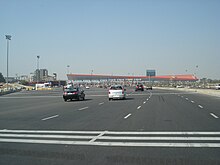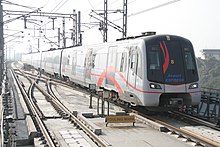This article needs additional or more specific categories .(January 2025) |
| Yashobhoomi | |
|---|---|
 Yashobhoomi International Convention Centre Main Auditorium | |
 | |
| Alternative names | India International Convention and Exhibition Centre |
| General information | |
| Type | Convention center |
| Architectural style | Contemporary architecture |
| Location | Sector 25, Dwarka, Delhi, India |
| Coordinates | 28°55′36″N077°04′00″E / 28.92667°N 77.06667°E |
| Groundbreaking | 20 September 2018 [1] |
| Completed | 15 September 2023 [2] |
| Opened | 17 September 2023 [2] |
| Cost | ₹25,700 crore (US$3.0 billion) |
| Client | India International Convention and Exhibition Center Limited |
| Owner | Government of India |
| Technical details | |
| Floor area | 73,000 sq.m. (Phase-I) 890,000 sq.m. (entire project) [2] |
| Design and construction | |
| Architecture firm | C P Kukreja Architects IDOM ARCOP Associates |
| Main contractor | Larsen & Toubro |
| Other information | |
| Seating capacity | 11,000 (Phase-I) |
| Public transit access | |
| Website | |
| Official website | |
Yashobhoomi (lit. "Land of Fame" ) is a convention center located in Sector 25, Dwarka, Delhi, India. [3] It is the largest convention center in India and Asia by area, and one of the biggest MICE facilities in the world. [4] [5] Prime Minister Narendra Modi laid Yashobhoomi's foundation stone on 20 September 2018. [6] [7] Construction began on the following day and Phase-I was expected to be completed by September 2022 so that Yashobhoomi could host the G20 Summit in 2023.
Contents
- Structure
- Main auditorium
- Grand Ballroom
- Features
- Connectivity
- Roadways
- Railways
- Airways
- See also
- References
- External links
However, labour shortages and slowdowns in work caused by the COVID-19 pandemic delayed completion to 15 September 2023. Yashobhoomi (Phase-I) was inaugurated by PM Modi On his birthday, September 17, 2023. [8] [9]
Its development cost ₹25,700 crore (US$3.0 billion), [1] [7] out of which its first phase costs ₹5,400 crore (US$620 million). The total area of the entire convention center is 890,000 m2, with built-up areas of over 100,000 m2 and 300,000 m2, while its first phase covers 73,000 m2. [2]


